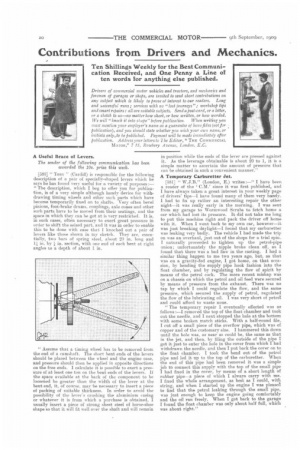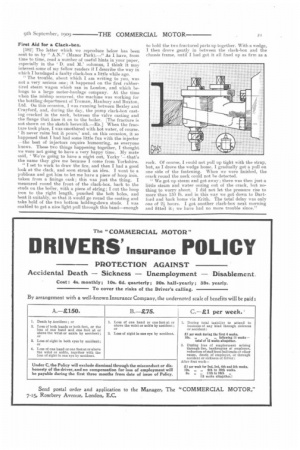Contributions from Drivers and Mechanics.
Page 22

Page 23

If you've noticed an error in this article please click here to report it so we can fix it.
Ten Shillings Weekly for the Best Communication Received, and One Penny a Line of ten words for anything else published.
Drivers of commercial motor vehicles and tractors, and mechanics and foreman of garages or shops, are invited to send short contributions on any subject which is likely to prove of interest to our readers, Long and successful runs ; services with no " lost journeys" ; workshop tips and smart repairs: allare suitable subjects. Send a post-card, or a letter, or a sketch to us—no matter how short, or how written, or how worded.
We will "knock it into shape" before publication. When writing you must mention your employer's name as a guarantee of bona fides (not for publication), and you should state whether you wish your own name, or initials only, to be published. Payment will be made immediately after publication. Address your letters to I Ire Editor," THE COMMERCIAL Moron," 7 15, Rosebery Avenue, London, E.C.
A Useful Brace of Levers.
The sender of the following communication has been awarded the .10s. prize this week.
[580] " Tour "(Cardiff) is responsible for the following description of a pair of specially-shaped levers which he says he has found very useful for a variety of purposes :— " The description, which I beg to offer you for publication, is of a very simple although handy device for withdrawing timing wheels and other such parts which have become temporarily fixed on to shafts. Very often bevel pinions, foot-brake drums, couplings, axle cones and other such parts have to be moved from their seatings, and the space in which they can be got at is very restricted. It is, in such cases, often necessary to exert great pressure in order to shift the seized part, and it was in order to enable this to be done with ease that I knocked out a pair of levers like those shown in. my sketch. They are, essentially, two bars of spring steel, about 20 in long and 1,', in. by in. section, with one end of each bent at right angles to a depth of about 1 in.
" Assume that a timing wiled has to be removed from the end of a camshaft, The short bent ends of the levers should be placed between the wheel and the engine case, and pressure should then be applied in opposite directions on the free ends. I calculate it is possible to exert a pressure of at least one ton on the bent ends of the levers. If the space available at the back of the component to be loosened be greater than the width of the lever at the bent end, it, of course, may-be necessary to insert a piece of packing of suitable thickness. In order to avoid the possibility of the lever's crushing the aluminium caaing or whatever it is from which a purchase is obtained, I usually insert a piece of strong sheet steel of horse-shoe shape so that it will fit well over the shaft and will remain in position while the ends of the lever are pressed against it. As the leverage obtainable is about 20 to I, it is a simple matter to ascertain the amount of pressure that can be obtained in such a convenient manner."
A Temporary Carburetter Jet.
[581] " W.J.B." (London, E.) writes :—" I have been a reader of the CAL since it was first published, and I have always taken a great interest in your weekly page of drivers' tips—I have found many of them very handy. I had to fix up rather an interesting repair the other night—it was really early in the morning. I was sent from my garage to Wormwood Scrubs to fetch home a ear which had lost its pressure. It did not take me long to put this machine right and pack the driver off home with it. When I went back to my own car, however—it was just breaking daylight—I found that my carburetter was leaking very badly. The vehicle I had made the trip on was an overhaul, just out of the shags for a trial spin. I naturally proceeded to tighten up the petrol-pipe union ; unfortunately the nipple broke clean off, as I found that there was a bad flaw in the casting, I bad a similar thing happen to me two years ago, but, as that was on a gravity-fed engine, I got home, on that occasion, by bending the supply pipe hook fashion into the float chamber, and by regulating the flow of spirit by means of the petrol cock. The more recent mishap was on a chassis on which the petrol and oil feed were secured by means of pressure from the exhaust. There was no tap by which I could regulate the flow, and the same pressure, which secured the supply of petrol, regulated the flow of the lubricating oil. I was very short of petrol and could afford to waste none.
" The temporary repair I eventually effected was as follows :—I removed the top of the float chamber and took out the needle, and I next stopped the hole at the bottom with some broken match sticks. With a half-round file, I cut off a small piece of the overflow pipe, which was of copper and of the customary size. I hammered this down until the hole was, as near as could be, the same as that in the jet, and then, by filing the outside of the pipe I got it just to enter the hole in the cover from which I had withdrawn the needle. and then I put back the cover on to the float chamber. I took the bend out of the petrol pipe and led it up to the top of the carburetter. When the end of this pipe had been removed it was a simple job tb connect this supply with the top of the small pipe I had fixed in the cover, by means of a short length of rubber pipe—a piece of which I always carry with me. I fixed the whole arrangement, as best as I could, with string, and when I started up the engine I was pleased to find that the petrol leaking through the small pipe, was just enough to keep the engine going comfortably and the oil ran freely. When I got back to the garage I found the float chamber was only about half full, which was about right."
First Aid for a Clack-box.
[582] The letter which we reproduce below has been sent to us by " A.N." (Manor Park).—" As I have, from time to time, read a number of useful hints in your paper, especially in the D. and M.' columns, I think it may interest some of my fellow readers if I describe the way in which I bandaged a faulty clack-box a little while ago.
" The trouble, about which I am writing to you, was not a very serious one ; it happened on the first rubbertired steam wagon which ran in London, and which belongs to a large motor-haulage company. At the time when the mishap occurred, the machine was working for the bottling department of Truman, Hanburyand Buxton. Ltd. On this oceasion,. I was running between Bexley and Crayford, and, during the day, the pump clack-box casting cracked in the neck, between the valve casting and the flange that fixes it on to the boiler. [The fracture is not shown on the sketch herewith.—ED.] When the fracture took place, I was smothered with hot water, of course. It never rains but it pours,' and, on this occasion, it so happened that I had had some little fun with the injector —the best of injectors require humouring, as everyone knows. These two things happening together, I thought we were not going to have a very happy time. My mate said, 'We're going to have a night out, Yorky '—that's the name they give me because I come from Yorkshire.
" I set to work to draw the fire, and then I had a good look at the clack, and soon struck an idea. I went to a publican and got him to let me have a piece of hoop iron, taken from a finings cask ; this was just the thing. I measured round the front of the clack-box, back to the studs on the boiler, with a piece of string ; I cut the hoop iron to the right length, punched the bolt holes, and bent it suitably, so that it would go round the casting and take hold of the two bottom holding-down studs. I was enabled to get a nice light pull through this band—enough to hold the two fractured parts up together. With a wedge, I then drove gently in between the clack-box and the chassis frame, until I had got it all fixed up as firm as a
rock. Of course, 1 could not pull up tight with the strap, but, as I drove the wedge home. I gradually got a pull on one side of the fastening. When we were finished, the crack round the neck could not he detected.
" We got up steam and got away: there was then just a little steam and water oozing out of the crack, but nothing to worry about. I did not let the pressure rise to more than 150 lb. and in this way we got down to Dartford and back home via Erith. The total delay was only one of 2:k hours. I got another clack-box next morning and fitted it ; we have had no more trouble since."
























